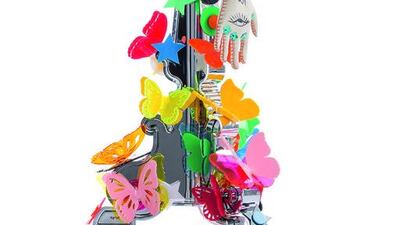As part of a global campaign to mark the 10th anniversary of the iconic Bourgie lamp, Kartell, in collaboration with S*uce, invited 10 regional designers to come up with their own version. Here are our five favourites.
1 Taking flight
You can always rely on Rana Salam to put a fun spin on things. The Lebanese designer has made a name for herself creating furniture and accessories inspired by Middle Eastern pop art. For her lamp, entitled Kiss Me Kwik, she employed a kitsch, pop-inspired colour palette and motifs, along with three-dimensional butterflies that look like they’re resting, seemingly temporarily, on the shade and base of the lamp.
2 Net gains
For her version of the Bourgie, Catching Light, the designer Nada Debs enclosed the entire lamp in a web of fluorescent yellow fishnet. The aim, she says, was to create “an ephemeral light effect”, with the bright pop of fluorescence intended to “catch” the light in a captivating way. We love the interplay of the colours and the simplicity of Debs’s solution.
3 The eyes have it
For her interpretation of the lamp, entitled Eye/I, the photographer and jewellery designer Nadine Kanso decided not to interfere too much with the aesthetic of the piece. Instead, she attached two bejewelled eyes to the top of the shade, in recognition of the symbolic importance of the eye in regional culture – not just the evil eye but the popular “ain”, which translates literally as “eye”, and is commonly used in music and poetry to express admiration and praise.
4 Blooming lovely
The fashion designer and S*uce founder Zayan Ghandour relied on the natural beauty of flowers for her heartwarming interpretation of the Bourgie. We love the stark, eye-catching contrast between the soft-coloured blooms, which are encased in Plexiglas, and the metallic sheen of the body of the lamp.
5 Planting an idea
Wael Hattar’s Forever More lamp is one of the cleverer designs. The base is transformed into a plant pot, with the vegetation seemingly pushing against the shade as it grows out from within. It’s meant as an exploration of the organic versus the industrial, and questions whether the two are actually at odds with each other. “Forever More is an examination of the notion of what may survive in the future after we are all gone,” Hattar says.
• The lamps were unveiled at Downtown Design and are now on show at S*uce Gifts on Al Wasl Road, Dubai
sdenman@thenational.ae
Follow us @LifeNationalUAE
Follow us on Facebook for discussions, entertainment, reviews, wellness and news.


